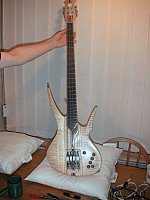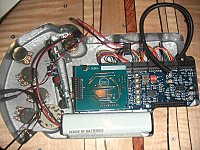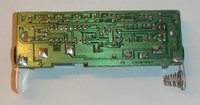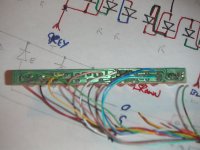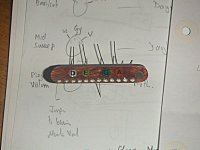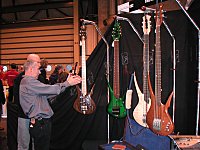This
is the bass that was to have the tuner fitted. Kim's guitars
are beautifully light because of the sculpted body, but this meant that
space was going to be tight.
|
The
bass uses the Lightwave
optical pickup. Because there is a fair amount of electronics to
support this Lightwave provide a rechargeable battery pack. This was a
good start because it meant we could use this to power the tuner when
required.
|
Rather
than design a tuner from scratch, we decided that we
should choose one of the most accurate tuners on the market and modify
it so it could be integrated into the bass. This is the
electronics PCB for the standard tuner.
|
The
display from the standard tuner was carefully separated from the rest
of the PCB and wired up so that it could be tested in its separated
form. The red LEDs on the tuner were changed to blue LEDs. As
these have a higher forward voltage drop than the red type I had to do
a special PSU circuit to keep the tuner circuitry happy.
|
|
The standard tuner has
the notes printed next to the LEDs but we
realised that it would be difficult to see any printed text
when on
stage. So we decided to use colour coded LEDs to back-light the notes
corresponding to the open strings. Kim made up this display assembly
so
it could be let into the guitar neck.
|
This new display module
was quite a bit smaller than the original PCB version and as
we did not want to make a one-off PCB Kim decided to wire the LED's by
hand. I gave him the circuit schematic and he then took it back to the
workshop to spend a few hours painstakingly wiring it up.
A few days later he brought it over to test, but when we
switched it on the LEDs came on in the wrong order - I'd made a mistake
in reverse-engineering the LED wiring! I corrected the circuit and the
poor chap had to undo all the wiring and re-wire it. Luckily it then
worked perfectly.
|
All that remained to be done was to wire up
the PSU and
tuner to the multiway switch and fit this electronics into the recess
in the body alongside the Lightwave electronics.
Here's the bass (and Kim) along with three other of his basses at the
guitar show.
|
|
|


